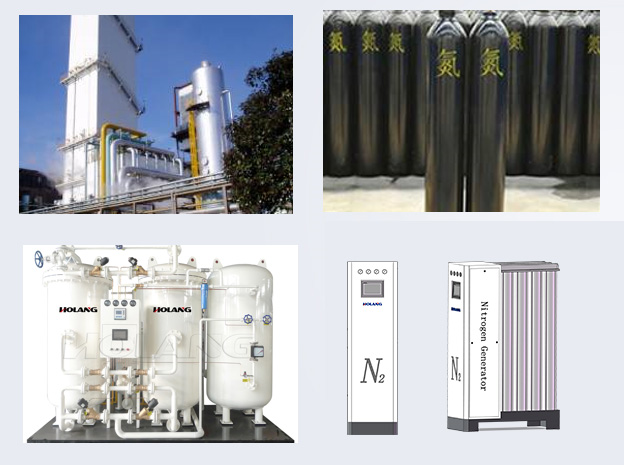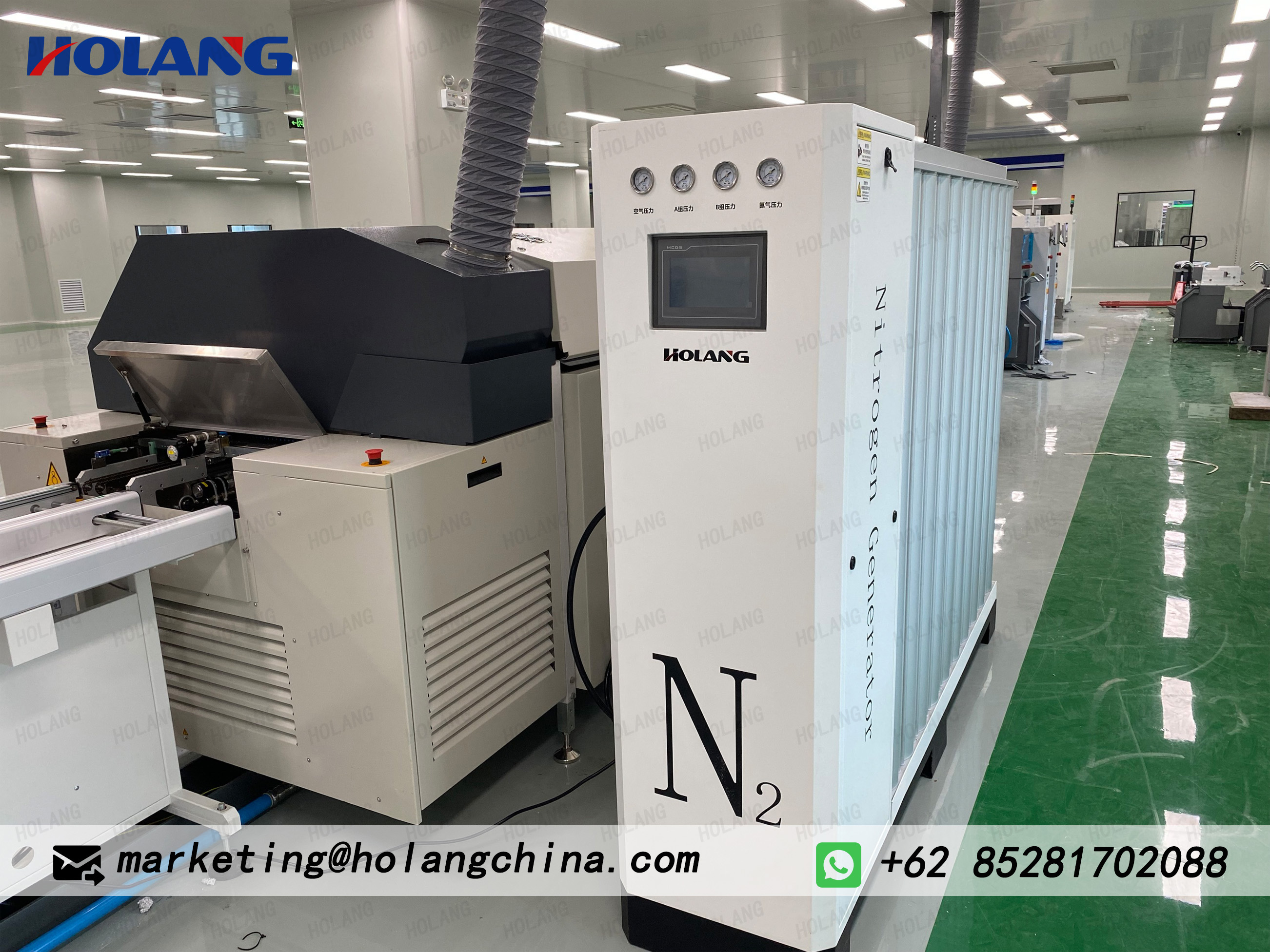How to obtain the correct nitrogen source in SMT industry
發(fā)布時(shí)間:2022-12-09 瀏覽次數(shù):966

How to Choose the Most Suitable Nitrogen Source for Production? How to Determine the Specific Parameters of the Nitrogen Atmosphere? How Much Does the Cost Increase? I believe these are the questions that all SMT companies are struggling with.

Holang Tech is dedicated to professional innovation and service in the field of industrial gas frontier technology, hoping to create higher value for all enterprises that need nitrogen. Let us explain in detail how to correctly obtain a nitrogen source.
Nitrogen source selection
In fact, there are several ways to supply nitrogen. You can have a gas fractionation tower, or you can purchase bottled nitrogen from a gas company, or you can purchase liquid nitrogen and on-site nitrogen generation from gas companies.
01 Large Nitrogen Demand
Gas companies or companies with large nitrogen consumption can equip themselves with gas fractionation towers. The working principle is to compress air, liquefy it, and then use the different boiling points of nitrogen and oxygen to fractionate them. This equipment takes up a large area and is expensive, making it unsuitable for general enterprises.
02 Small Nitrogen Demand
Users with small nitrogen quantities can purchase nitrogen in steel cylinders from gas companies. Nitrogen is stored in high-pressure steel cylinders and then transported directly to the point of use. Bottled nitrogen has the advantages of on-demand use and flexibility. However, it is also high-risk, costly, and troublesome to transport and store. If bottled nitrogen can no longer meet current production needs, you should purchase liquid nitrogen from gas companies or choose on-site nitrogen generation.
Liquid nitrogen is stored in liquid ammonia tanks or Dewar flasks. When needed, liquid nitrogen is vaporized into gaseous nitrogen and can only be used after pressure reduction and temperature increase. Liquid nitrogen is convenient and fast, and can be used on demand. However, the liquid nitrogen in the storage tank needs to be replenished frequently, which brings trouble and pressure to procurement and transportation. At the same time, long-term and large-scale use of liquid nitrogen incurs high costs, transportation issues, and is greatly affected by the supply source, resulting in significant overall investment.
On-site nitrogen generation includes membrane separation nitrogen generation and pressure swing adsorption (PSA) nitrogen generation.
Membrane separation nitrogen generation is a high-tech technology that emerged in the 1980s. This equipment uses air as the raw material and hollow fiber membranes for the separation and utilization of oxygen and nitrogen, with different permeation rates in the membrane structure—water and oxygen can pass through while nitrogen cannot, thus achieving oxygen-nitrogen separation. The nitrogen produced by membrane separation nitrogen generators has a lower purity, generally between 95-99.9%. Moreover, membrane separation nitrogen generators consume a large amount of energy, and their core component, the hollow fiber membrane, relies mainly on imports, resulting in high prices, long delivery cycles, and troublesome equipment maintenance.
PSA nitrogen generation mainly uses carbon molecular sieves as adsorbents and compressed air as the main raw material. It utilizes the different adsorption rates of oxygen and nitrogen. Carbon molecular sieves preferentially adsorb oxygen, while most nitrogen enriches in the non-adsorbed phase, thereby achieving the separation of oxygen and nitrogen to obtain the gas we need. By using this principle and process of pressure swing adsorption, dual adsorption towers are used to alternate adsorption and regeneration, enabling continuous nitrogen production. It is possible to obtain qualified product nitrogen with a purity of 99-99.999% in one go. Among them, Holang Tech has developed a modular nitrogen generator that can be used on-site according to the production needs of the current SMT industry.
How to Determine the Specific Parameters of the Nitrogen Atmosphere
Before deciding to use nitrogen, SMT users should first determine the nitrogen purity (or ppm value of oxygen content) in the furnace, and then determine the outlet purity of the nitrogen generator.
The necessary condition for oxidation reactions is the presence of oxygen molecules. Under the same conditions, the higher the oxygen content, the more intense the oxidation reaction; conversely, the lower the oxygen content, the weaker the oxidation reaction. Of course, higher nitrogen purity is better, but the investment cost should be considered in balance with the defect rate and rework volume of the products. Therefore, the exact purity should be determined based on factors such as product grade, allowable defect rate, company policy, and product requirements for wettability.
For SMT factories, nitrogen generation equipment is not placed in the workshop together with the SMT production line. Instead, it is placed on the roof or outside the workshop and input into the furnace through pipelines. There are many connection points (which are prone to leaks and result in increased oxygen content). This can easily cause a decrease in nitrogen purity. In addition, the gas consumption per unit time (usually calculated in cubic meters per hour) varies for different brands and models of furnaces, different sizes of PCBs, and different speeds of chain rotation, even if we know the exact gas consumption, insufficient gas supply may still occur.

Modular nitrogen generators can perfectly solve this problem. They have a small footprint, low noise, and are not pressure vessels, so they can be used in the workshop. (The above picture shows the on-site use of a 30Nm3/h, 99.99% purity nitrogen generator.)
Cost Analysis
Below is a brief economic analysis and comparison of using a nitrogen purity of 99.99% and a gas production rate of 20Nm3/h for an SMT production line (electricity cost calculated at 0.6 RMB, operating 8,000 hours per year):
Cost of Using Liquid Nitrogen
Liquid nitrogen on the market is approximately 1,200 RMB/ton and can be vaporized into 780m3 of gaseous nitrogen with a purity of 99.99%. The price of purchasing 1m3 of nitrogen gas is around 1.4 RMB. If we include the rental cost of the liquid nitrogen tank, the purchase cost of the vaporizer, and the annual labor cost, the cost of using 1m3 of nitrogen gas is close to 1.6 RMB.
Cost of Using Modular Nitrogen Generator
Modular nitrogen generators can be used on-site without the need for additional workshops. The main cost comes from the consumption of electricity, which mainly includes:
Air compressor: The rated power of the air compressor is 22kW, and the power consumption is approximately 80% of the rated power, which is around 17.6 kW.
Refrigerated air dryer: The rated power of the refrigerated air dryer is 1 kW.
Modular Nitrogen Generator: The raw material for the modular nitrogen generator is compressed air, which itself consumes minimal electricity. Its main electricity consumption is from the instruments, with a rated power of approximately 0.4 kW.
The total annual electricity cost is: (17.6 + 1 + 0.4) x 8000 x 0.6 = 9.12 million RMB.
Equipment Depreciation Cost: Based on an equipment investment of 200,000 RMB, the yearly depreciation cost is 20,000 RMB.
The total annual cost is: (9.12 + 2) = 11.12 million RMB.
The cost per cubic meter of nitrogen is 11,2000/800/0.6 = 0.7 RMB.
The price difference between the two methods of using nitrogen is 20 x 8000 x (1.7-0.7) = 160,000 RMB per year.
Therefore, the payback period for investing in a modular nitrogen generator is only 10 months. (That is, 160,000/200,000 x 12)
From the above cost analysis, it can be concluded that a modular nitrogen generator is more suitable for use in SMT production lines.
A modular nitrogen generator avoids the inconvenience and high cost of bottled nitrogen and Dewar flasks. It can be used on-site, and nitrogen supply does not have to rely on retailers, avoiding the dangers of high-pressure bottled ammonia and the losses caused by production stoppages due to gas supply interruptions. The long-term stable and low-cost operation of a modular nitrogen generator can avoid uncontrollable gas price increases and expensive tank rental costs. It is also easy to operate and does not require additional gas tanks. It can recoup its cost in a short period of time. It requires no specialized maintenance and is easy to repair. Therefore, once we install a modular nitrogen generator, we can extract nitrogen from the air at our convenience.
